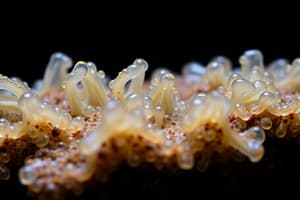Podcast
Questions and Answers
What are extremophiles?
What are extremophiles?
- Organisms that can only survive in moderate environments
- Organisms that can only survive in mild environments
- Organisms that can only survive in cold environments
- Organisms that can live in extreme environments (correct)
What are some conditions that extremophiles can survive?
What are some conditions that extremophiles can survive?
- Cold temperature, radiation, salinity, or pH level
- Mild temperature, radiation, salinity, or pH level
- Extreme temperature, radiation, salinity, or pH level (correct)
- Moderate temperature, radiation, salinity, or pH level
Why are extremophiles ecologically dominant in the evolutionary history of the planet?
Why are extremophiles ecologically dominant in the evolutionary history of the planet?
- They have adapted to moderate environments better than other organisms
- They have adapted to cold environments better than other organisms
- They have adapted to mild environments better than other organisms
- They have continued to thrive in the most extreme conditions (correct)
What is the potential use of extremophiles in bioremediation?
What is the potential use of extremophiles in bioremediation?
What is the significance of studying extreme environments on Earth?
What is the significance of studying extreme environments on Earth?
Which organism is known for being one of the most radioresistant organisms?
Which organism is known for being one of the most radioresistant organisms?
How is DNA transfer achieved in Sulfolobus?
How is DNA transfer achieved in Sulfolobus?
What is the potential function of extracellular membrane vesicles (MVs) in DNA transfer?
What is the potential function of extracellular membrane vesicles (MVs) in DNA transfer?
What is the potential significance of DNA transfer in Sulfolobus under DNA damaging conditions?
What is the potential significance of DNA transfer in Sulfolobus under DNA damaging conditions?
Flashcards
Extremophiles
Extremophiles
Organisms that thrive in extreme conditions, such as extreme temperatures, radiation, salinity, or pH levels.
Abundant lifeforms
Abundant lifeforms
They have continued to thrive in the most extreme conditions, making them one of the most abundant lifeforms.
Habitability on other worlds
Habitability on other worlds
Studying extreme environments on Earth can help researchers understand the limits of habitability on other worlds.
Astrobiology and Extremophiles
Astrobiology and Extremophiles
Signup and view all the flashcards
Bioremediation with Extremophiles
Bioremediation with Extremophiles
Signup and view all the flashcards
Remediation Applications
Remediation Applications
Signup and view all the flashcards
DNA modifying enzymes
DNA modifying enzymes
Signup and view all the flashcards
Naturally competent for genetic transformation
Naturally competent for genetic transformation
Signup and view all the flashcards
DNA exchange in Sulfolobus
DNA exchange in Sulfolobus
Signup and view all the flashcards
Study Notes
Organisms capable of living in extreme environments:
-
Extremophiles are organisms that can live or thrive in extreme environments.
-
They can survive conditions such as extreme temperature, radiation, salinity, or pH level.
-
Some spores and cocooned bacteria samples have been dormant for more than 40 million years.
-
Extremophiles are ecologically dominant in the evolutionary history of the planet.
-
They have continued to thrive in the most extreme conditions, making them one of the most abundant lifeforms.
-
Studying extreme environments on Earth can help researchers understand the limits of habitability on other worlds.
-
Astrobiologists are particularly interested in studying extremophiles to map what is known about the limits of life on Earth to potential extraterrestrial environments.
-
Extremophiles can be useful players in the bioremediation of contaminated sites.
-
They can also be effective in remediating metals, acid mine drainage, and radioactive materials.
-
New sub-types of extremophiles are identified frequently, and the sub-category list for extremophiles is always growing.
-
Studying these organisms may help illuminate the mechanisms of both toxicity and deficiency in certain elements.
-
The T. brockianus catalase has applications for removal of hydrogen peroxide in industrial processes.DNA Transfer in Extremophiles
-
Several biotechnology companies produce DNA modifying enzymes commercially.
-
Over 65 prokaryotic species are known to be naturally competent for genetic transformation.
-
D. radiodurans is one of the most radioresistant organisms known and is competent to perform genetic transformation.
-
Thermus thermophilus and other related Thermus species are also capable of genetic transformation.
-
Halobacterium volcanii is capable of natural genetic transformation using cytoplasmic bridges.
-
Sulfolobus solfataricus and Sulfolobus acidocaldarius are hyperthermophilic archaea capable of DNA transfer via cellular aggregation and homologous recombination.
-
Cellular aggregation in Sulfolobus may enhance species-specific DNA transfer between cells to repair damaged DNA.
-
Extracellular membrane vesicles (MVs) might be involved in DNA transfer between different hyperthermophilic archaeal species.
-
Plasmids and viral genomes can be transferred via MVs.
-
A horizontal plasmid transfer has been documented between hyperthermophilic Thermococcus and Methanocaldococcus species.
-
DNA transfer in Sulfolobus may be an early form of sexual interaction.
-
The DNA exchange process in Sulfolobus may be crucial under DNA damaging conditions such as high temperatures.
Studying That Suits You
Use AI to generate personalized quizzes and flashcards to suit your learning preferences.




